Clinical Decision Making in Trauma Care
VerifiedAdded on 2021/04/17
|10
|2825
|490
AI Summary
The provided document appears to be a solution to an assignment related to clinical decision making in trauma care. It includes references to several research papers and case studies that discuss the importance of appropriate blood component ratios in patients with severe trauma. The document also mentions various medications administered to a patient, including acetaminophen, amoxicillin, enoxaparin, nalbuphine, and alprazolam. However, due to the incomplete nature of the provided text, it is unclear what specific task or question the assignment is addressing.
Contribute Materials
Your contribution can guide someone’s learning journey. Share your
documents today.

Running head: ADVANCED CLINICAL DECISION MAKING
Advanced clinical decision making
Name of the student:
Name of the University:
Author’s note
Advanced clinical decision making
Name of the student:
Name of the University:
Author’s note
Secure Best Marks with AI Grader
Need help grading? Try our AI Grader for instant feedback on your assignments.
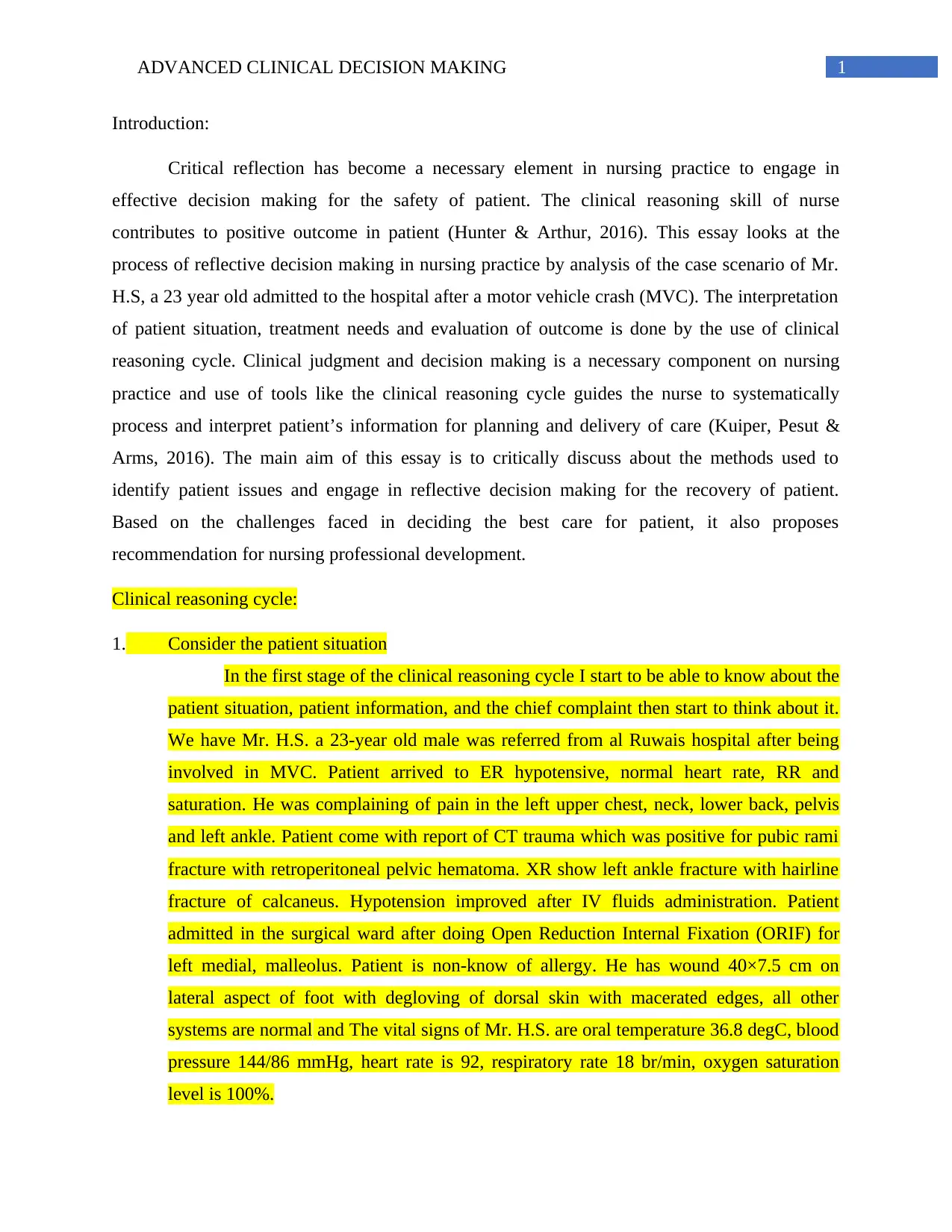
1ADVANCED CLINICAL DECISION MAKING
Introduction:
Critical reflection has become a necessary element in nursing practice to engage in
effective decision making for the safety of patient. The clinical reasoning skill of nurse
contributes to positive outcome in patient (Hunter & Arthur, 2016). This essay looks at the
process of reflective decision making in nursing practice by analysis of the case scenario of Mr.
H.S, a 23 year old admitted to the hospital after a motor vehicle crash (MVC). The interpretation
of patient situation, treatment needs and evaluation of outcome is done by the use of clinical
reasoning cycle. Clinical judgment and decision making is a necessary component on nursing
practice and use of tools like the clinical reasoning cycle guides the nurse to systematically
process and interpret patient’s information for planning and delivery of care (Kuiper, Pesut &
Arms, 2016). The main aim of this essay is to critically discuss about the methods used to
identify patient issues and engage in reflective decision making for the recovery of patient.
Based on the challenges faced in deciding the best care for patient, it also proposes
recommendation for nursing professional development.
Clinical reasoning cycle:
1. Consider the patient situation
In the first stage of the clinical reasoning cycle I start to be able to know about the
patient situation, patient information, and the chief complaint then start to think about it.
We have Mr. H.S. a 23-year old male was referred from al Ruwais hospital after being
involved in MVC. Patient arrived to ER hypotensive, normal heart rate, RR and
saturation. He was complaining of pain in the left upper chest, neck, lower back, pelvis
and left ankle. Patient come with report of CT trauma which was positive for pubic rami
fracture with retroperitoneal pelvic hematoma. XR show left ankle fracture with hairline
fracture of calcaneus. Hypotension improved after IV fluids administration. Patient
admitted in the surgical ward after doing Open Reduction Internal Fixation (ORIF) for
left medial, malleolus. Patient is non-know of allergy. He has wound 40×7.5 cm on
lateral aspect of foot with degloving of dorsal skin with macerated edges, all other
systems are normal and The vital signs of Mr. H.S. are oral temperature 36.8 degC, blood
pressure 144/86 mmHg, heart rate is 92, respiratory rate 18 br/min, oxygen saturation
level is 100%.
Introduction:
Critical reflection has become a necessary element in nursing practice to engage in
effective decision making for the safety of patient. The clinical reasoning skill of nurse
contributes to positive outcome in patient (Hunter & Arthur, 2016). This essay looks at the
process of reflective decision making in nursing practice by analysis of the case scenario of Mr.
H.S, a 23 year old admitted to the hospital after a motor vehicle crash (MVC). The interpretation
of patient situation, treatment needs and evaluation of outcome is done by the use of clinical
reasoning cycle. Clinical judgment and decision making is a necessary component on nursing
practice and use of tools like the clinical reasoning cycle guides the nurse to systematically
process and interpret patient’s information for planning and delivery of care (Kuiper, Pesut &
Arms, 2016). The main aim of this essay is to critically discuss about the methods used to
identify patient issues and engage in reflective decision making for the recovery of patient.
Based on the challenges faced in deciding the best care for patient, it also proposes
recommendation for nursing professional development.
Clinical reasoning cycle:
1. Consider the patient situation
In the first stage of the clinical reasoning cycle I start to be able to know about the
patient situation, patient information, and the chief complaint then start to think about it.
We have Mr. H.S. a 23-year old male was referred from al Ruwais hospital after being
involved in MVC. Patient arrived to ER hypotensive, normal heart rate, RR and
saturation. He was complaining of pain in the left upper chest, neck, lower back, pelvis
and left ankle. Patient come with report of CT trauma which was positive for pubic rami
fracture with retroperitoneal pelvic hematoma. XR show left ankle fracture with hairline
fracture of calcaneus. Hypotension improved after IV fluids administration. Patient
admitted in the surgical ward after doing Open Reduction Internal Fixation (ORIF) for
left medial, malleolus. Patient is non-know of allergy. He has wound 40×7.5 cm on
lateral aspect of foot with degloving of dorsal skin with macerated edges, all other
systems are normal and The vital signs of Mr. H.S. are oral temperature 36.8 degC, blood
pressure 144/86 mmHg, heart rate is 92, respiratory rate 18 br/min, oxygen saturation
level is 100%.
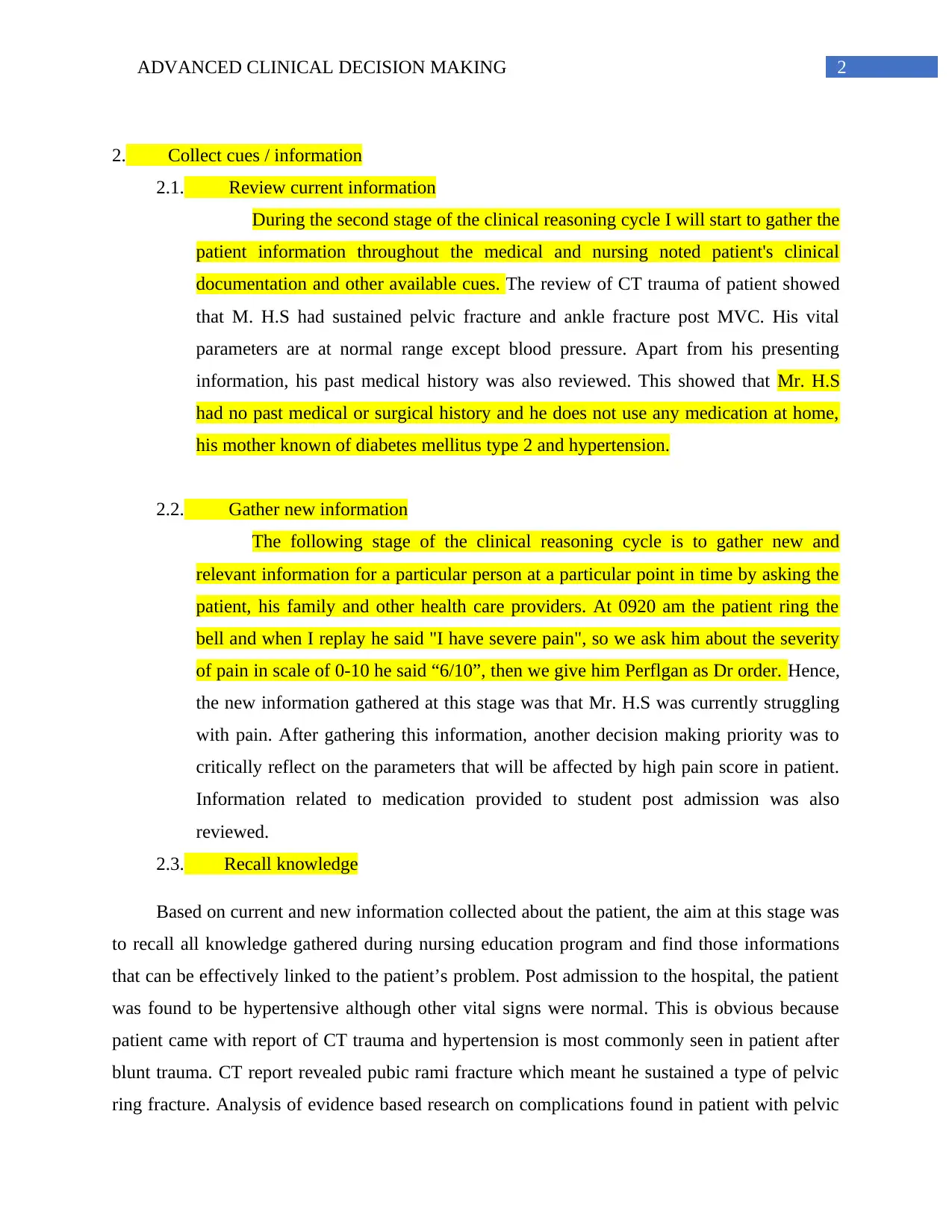
2ADVANCED CLINICAL DECISION MAKING
2. Collect cues / information
2.1. Review current information
During the second stage of the clinical reasoning cycle I will start to gather the
patient information throughout the medical and nursing noted patient's clinical
documentation and other available cues. The review of CT trauma of patient showed
that M. H.S had sustained pelvic fracture and ankle fracture post MVC. His vital
parameters are at normal range except blood pressure. Apart from his presenting
information, his past medical history was also reviewed. This showed that Mr. H.S
had no past medical or surgical history and he does not use any medication at home,
his mother known of diabetes mellitus type 2 and hypertension.
2.2. Gather new information
The following stage of the clinical reasoning cycle is to gather new and
relevant information for a particular person at a particular point in time by asking the
patient, his family and other health care providers. At 0920 am the patient ring the
bell and when I replay he said "I have severe pain", so we ask him about the severity
of pain in scale of 0-10 he said “6/10”, then we give him Perflgan as Dr order. Hence,
the new information gathered at this stage was that Mr. H.S was currently struggling
with pain. After gathering this information, another decision making priority was to
critically reflect on the parameters that will be affected by high pain score in patient.
Information related to medication provided to student post admission was also
reviewed.
2.3. Recall knowledge
Based on current and new information collected about the patient, the aim at this stage was
to recall all knowledge gathered during nursing education program and find those informations
that can be effectively linked to the patient’s problem. Post admission to the hospital, the patient
was found to be hypertensive although other vital signs were normal. This is obvious because
patient came with report of CT trauma and hypertension is most commonly seen in patient after
blunt trauma. CT report revealed pubic rami fracture which meant he sustained a type of pelvic
ring fracture. Analysis of evidence based research on complications found in patient with pelvic
2. Collect cues / information
2.1. Review current information
During the second stage of the clinical reasoning cycle I will start to gather the
patient information throughout the medical and nursing noted patient's clinical
documentation and other available cues. The review of CT trauma of patient showed
that M. H.S had sustained pelvic fracture and ankle fracture post MVC. His vital
parameters are at normal range except blood pressure. Apart from his presenting
information, his past medical history was also reviewed. This showed that Mr. H.S
had no past medical or surgical history and he does not use any medication at home,
his mother known of diabetes mellitus type 2 and hypertension.
2.2. Gather new information
The following stage of the clinical reasoning cycle is to gather new and
relevant information for a particular person at a particular point in time by asking the
patient, his family and other health care providers. At 0920 am the patient ring the
bell and when I replay he said "I have severe pain", so we ask him about the severity
of pain in scale of 0-10 he said “6/10”, then we give him Perflgan as Dr order. Hence,
the new information gathered at this stage was that Mr. H.S was currently struggling
with pain. After gathering this information, another decision making priority was to
critically reflect on the parameters that will be affected by high pain score in patient.
Information related to medication provided to student post admission was also
reviewed.
2.3. Recall knowledge
Based on current and new information collected about the patient, the aim at this stage was
to recall all knowledge gathered during nursing education program and find those informations
that can be effectively linked to the patient’s problem. Post admission to the hospital, the patient
was found to be hypertensive although other vital signs were normal. This is obvious because
patient came with report of CT trauma and hypertension is most commonly seen in patient after
blunt trauma. CT report revealed pubic rami fracture which meant he sustained a type of pelvic
ring fracture. Analysis of evidence based research on complications found in patient with pelvic

3ADVANCED CLINICAL DECISION MAKING
fracture revealed that such kind of fracture occurs in patient when they have multiple organ
injuries. Hence, such kinds of injuries lead to hypertension in patient.
3. Process information
3.1 Interpret
The main priority at this stage was to carefully look at all the current and past medical
information of patient and find immediate clinical care priorities for patient. His vital sign
observation included, blood pressure 144/86 mmHg, heart rate is 92, respiratory rate 18 br/min
and 100% oxygen saturation rate. His respiratory rate is in normal range as it is within normal
range of 12 to 20 breaths per minute. Despite a blunt trauma injury, his heart also falls within
normal range (60-100 beats/min). However, his blood pressure value was 144/86 mm Hg
compared to normal range of 120/80 thus indicating that patient was hypertensive. Use of several
medications and the trauma associated with injury might have increased his blood pressure.
Evidence has proved that hypertension is one of the common medical comorbidities in patient
after fracture. Hence, taking action to control hypertension at the early stage will be beneficial
for patient (Yang, Chen & Wu, 2015).
3.2 Discriminate
Although different types of information of patient were analyzed in the stage of
collecting cues, however the most important data that should be a focus of attention at this stage
is high blood pressure, pain score and his wound at the foot. The wound assessment at the foot
showed degloving of dorsal skin with macerated edges. Hence, pain management and wound
management is regarded as the most important clinical priority for patient at this stage.
3.3 Relate
The information gather so far has some links with each other and reflecting on this
connection is necessary to understand the mechanism behind complication in patient. As the
patient had no history of smoking or alcohol consumption or other disease like diabetes, the rise
in blood pressure due to past social or medical history is ruled out. However, link between
trauma related fracture/injury and pain and hypertension has been established. As he was found
positive for pubic rami fracture with retroperitoneal pelvic hematoma, this increases patient
fracture revealed that such kind of fracture occurs in patient when they have multiple organ
injuries. Hence, such kinds of injuries lead to hypertension in patient.
3. Process information
3.1 Interpret
The main priority at this stage was to carefully look at all the current and past medical
information of patient and find immediate clinical care priorities for patient. His vital sign
observation included, blood pressure 144/86 mmHg, heart rate is 92, respiratory rate 18 br/min
and 100% oxygen saturation rate. His respiratory rate is in normal range as it is within normal
range of 12 to 20 breaths per minute. Despite a blunt trauma injury, his heart also falls within
normal range (60-100 beats/min). However, his blood pressure value was 144/86 mm Hg
compared to normal range of 120/80 thus indicating that patient was hypertensive. Use of several
medications and the trauma associated with injury might have increased his blood pressure.
Evidence has proved that hypertension is one of the common medical comorbidities in patient
after fracture. Hence, taking action to control hypertension at the early stage will be beneficial
for patient (Yang, Chen & Wu, 2015).
3.2 Discriminate
Although different types of information of patient were analyzed in the stage of
collecting cues, however the most important data that should be a focus of attention at this stage
is high blood pressure, pain score and his wound at the foot. The wound assessment at the foot
showed degloving of dorsal skin with macerated edges. Hence, pain management and wound
management is regarded as the most important clinical priority for patient at this stage.
3.3 Relate
The information gather so far has some links with each other and reflecting on this
connection is necessary to understand the mechanism behind complication in patient. As the
patient had no history of smoking or alcohol consumption or other disease like diabetes, the rise
in blood pressure due to past social or medical history is ruled out. However, link between
trauma related fracture/injury and pain and hypertension has been established. As he was found
positive for pubic rami fracture with retroperitoneal pelvic hematoma, this increases patient
Secure Best Marks with AI Grader
Need help grading? Try our AI Grader for instant feedback on your assignments.
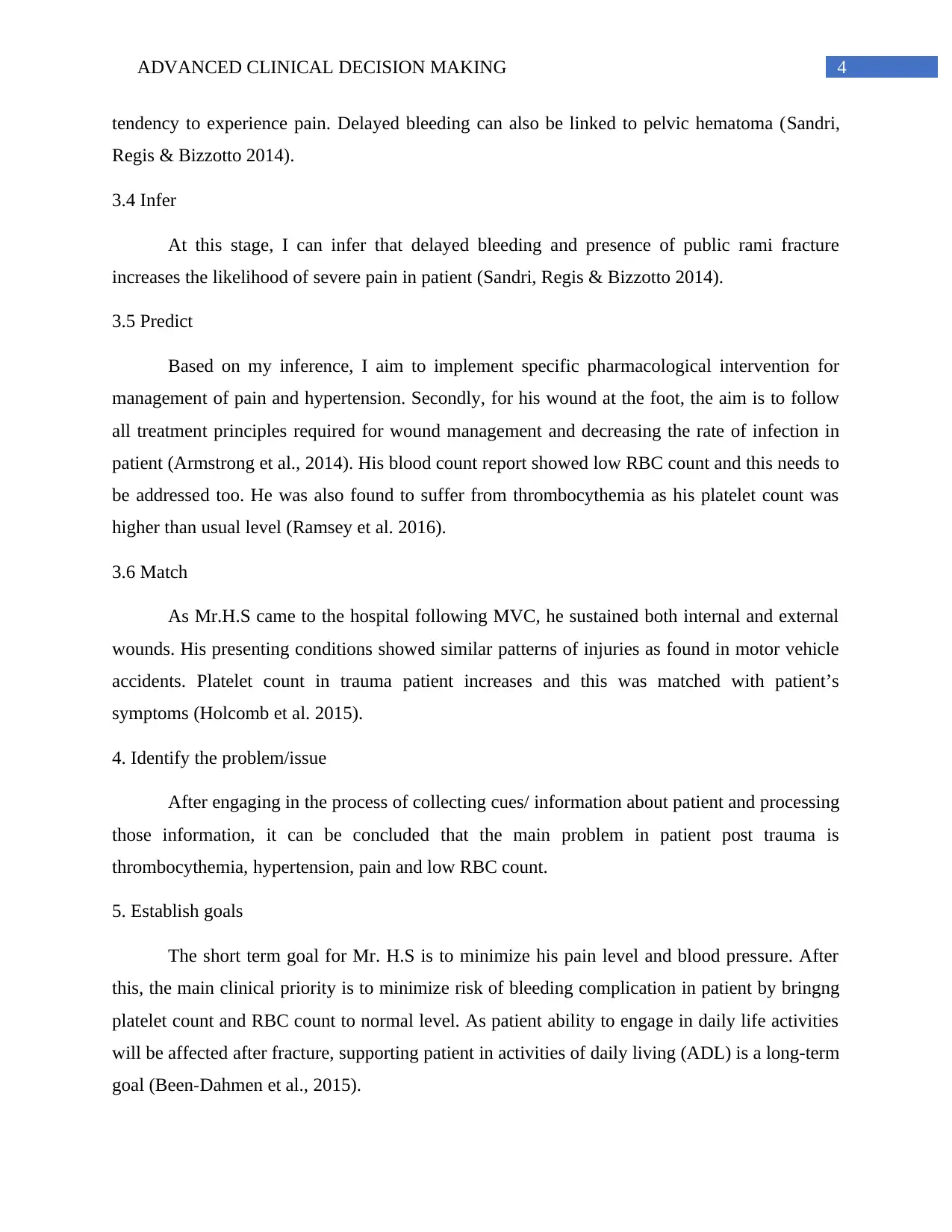
4ADVANCED CLINICAL DECISION MAKING
tendency to experience pain. Delayed bleeding can also be linked to pelvic hematoma (Sandri,
Regis & Bizzotto 2014).
3.4 Infer
At this stage, I can infer that delayed bleeding and presence of public rami fracture
increases the likelihood of severe pain in patient (Sandri, Regis & Bizzotto 2014).
3.5 Predict
Based on my inference, I aim to implement specific pharmacological intervention for
management of pain and hypertension. Secondly, for his wound at the foot, the aim is to follow
all treatment principles required for wound management and decreasing the rate of infection in
patient (Armstrong et al., 2014). His blood count report showed low RBC count and this needs to
be addressed too. He was also found to suffer from thrombocythemia as his platelet count was
higher than usual level (Ramsey et al. 2016).
3.6 Match
As Mr.H.S came to the hospital following MVC, he sustained both internal and external
wounds. His presenting conditions showed similar patterns of injuries as found in motor vehicle
accidents. Platelet count in trauma patient increases and this was matched with patient’s
symptoms (Holcomb et al. 2015).
4. Identify the problem/issue
After engaging in the process of collecting cues/ information about patient and processing
those information, it can be concluded that the main problem in patient post trauma is
thrombocythemia, hypertension, pain and low RBC count.
5. Establish goals
The short term goal for Mr. H.S is to minimize his pain level and blood pressure. After
this, the main clinical priority is to minimize risk of bleeding complication in patient by bringng
platelet count and RBC count to normal level. As patient ability to engage in daily life activities
will be affected after fracture, supporting patient in activities of daily living (ADL) is a long-term
goal (Been‐Dahmen et al., 2015).
tendency to experience pain. Delayed bleeding can also be linked to pelvic hematoma (Sandri,
Regis & Bizzotto 2014).
3.4 Infer
At this stage, I can infer that delayed bleeding and presence of public rami fracture
increases the likelihood of severe pain in patient (Sandri, Regis & Bizzotto 2014).
3.5 Predict
Based on my inference, I aim to implement specific pharmacological intervention for
management of pain and hypertension. Secondly, for his wound at the foot, the aim is to follow
all treatment principles required for wound management and decreasing the rate of infection in
patient (Armstrong et al., 2014). His blood count report showed low RBC count and this needs to
be addressed too. He was also found to suffer from thrombocythemia as his platelet count was
higher than usual level (Ramsey et al. 2016).
3.6 Match
As Mr.H.S came to the hospital following MVC, he sustained both internal and external
wounds. His presenting conditions showed similar patterns of injuries as found in motor vehicle
accidents. Platelet count in trauma patient increases and this was matched with patient’s
symptoms (Holcomb et al. 2015).
4. Identify the problem/issue
After engaging in the process of collecting cues/ information about patient and processing
those information, it can be concluded that the main problem in patient post trauma is
thrombocythemia, hypertension, pain and low RBC count.
5. Establish goals
The short term goal for Mr. H.S is to minimize his pain level and blood pressure. After
this, the main clinical priority is to minimize risk of bleeding complication in patient by bringng
platelet count and RBC count to normal level. As patient ability to engage in daily life activities
will be affected after fracture, supporting patient in activities of daily living (ADL) is a long-term
goal (Been‐Dahmen et al., 2015).
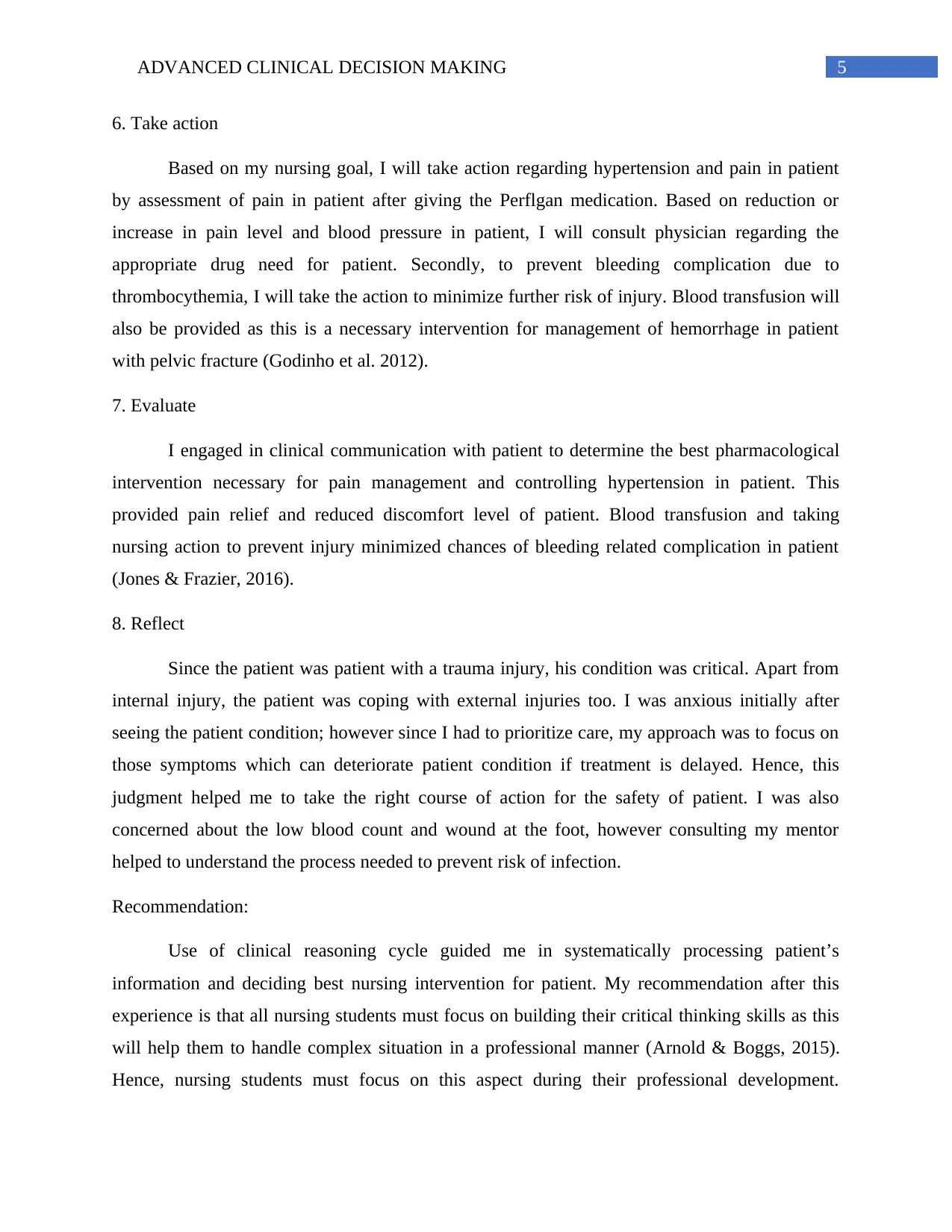
5ADVANCED CLINICAL DECISION MAKING
6. Take action
Based on my nursing goal, I will take action regarding hypertension and pain in patient
by assessment of pain in patient after giving the Perflgan medication. Based on reduction or
increase in pain level and blood pressure in patient, I will consult physician regarding the
appropriate drug need for patient. Secondly, to prevent bleeding complication due to
thrombocythemia, I will take the action to minimize further risk of injury. Blood transfusion will
also be provided as this is a necessary intervention for management of hemorrhage in patient
with pelvic fracture (Godinho et al. 2012).
7. Evaluate
I engaged in clinical communication with patient to determine the best pharmacological
intervention necessary for pain management and controlling hypertension in patient. This
provided pain relief and reduced discomfort level of patient. Blood transfusion and taking
nursing action to prevent injury minimized chances of bleeding related complication in patient
(Jones & Frazier, 2016).
8. Reflect
Since the patient was patient with a trauma injury, his condition was critical. Apart from
internal injury, the patient was coping with external injuries too. I was anxious initially after
seeing the patient condition; however since I had to prioritize care, my approach was to focus on
those symptoms which can deteriorate patient condition if treatment is delayed. Hence, this
judgment helped me to take the right course of action for the safety of patient. I was also
concerned about the low blood count and wound at the foot, however consulting my mentor
helped to understand the process needed to prevent risk of infection.
Recommendation:
Use of clinical reasoning cycle guided me in systematically processing patient’s
information and deciding best nursing intervention for patient. My recommendation after this
experience is that all nursing students must focus on building their critical thinking skills as this
will help them to handle complex situation in a professional manner (Arnold & Boggs, 2015).
Hence, nursing students must focus on this aspect during their professional development.
6. Take action
Based on my nursing goal, I will take action regarding hypertension and pain in patient
by assessment of pain in patient after giving the Perflgan medication. Based on reduction or
increase in pain level and blood pressure in patient, I will consult physician regarding the
appropriate drug need for patient. Secondly, to prevent bleeding complication due to
thrombocythemia, I will take the action to minimize further risk of injury. Blood transfusion will
also be provided as this is a necessary intervention for management of hemorrhage in patient
with pelvic fracture (Godinho et al. 2012).
7. Evaluate
I engaged in clinical communication with patient to determine the best pharmacological
intervention necessary for pain management and controlling hypertension in patient. This
provided pain relief and reduced discomfort level of patient. Blood transfusion and taking
nursing action to prevent injury minimized chances of bleeding related complication in patient
(Jones & Frazier, 2016).
8. Reflect
Since the patient was patient with a trauma injury, his condition was critical. Apart from
internal injury, the patient was coping with external injuries too. I was anxious initially after
seeing the patient condition; however since I had to prioritize care, my approach was to focus on
those symptoms which can deteriorate patient condition if treatment is delayed. Hence, this
judgment helped me to take the right course of action for the safety of patient. I was also
concerned about the low blood count and wound at the foot, however consulting my mentor
helped to understand the process needed to prevent risk of infection.
Recommendation:
Use of clinical reasoning cycle guided me in systematically processing patient’s
information and deciding best nursing intervention for patient. My recommendation after this
experience is that all nursing students must focus on building their critical thinking skills as this
will help them to handle complex situation in a professional manner (Arnold & Boggs, 2015).
Hence, nursing students must focus on this aspect during their professional development.

6ADVANCED CLINICAL DECISION MAKING
Secondly, they must also learn the skills to therapeutically communicate with patient as this will
help nurses to engage patients in decision making too (Sharpe & Hemsley, 2016).
Conclusion:
The essay gave an insight into the process of reflective decision making and prioritizing
and evaluating care of a patient by the analysis of Mr. H.A case. The steps mentioned in the
clinical reasoning cycle helped in framing the patient information, processing health information
and differentiating the vital information necessary for deciding the best intervention for patient.
Collaboration with relevant health care team also support nurse to advocate for the safety of
patient and take the best course of action for improving their quality of life. Student nurse who
aim to become a registered nurse should focus on critical thinking skills as part of their
professional development goal.
Secondly, they must also learn the skills to therapeutically communicate with patient as this will
help nurses to engage patients in decision making too (Sharpe & Hemsley, 2016).
Conclusion:
The essay gave an insight into the process of reflective decision making and prioritizing
and evaluating care of a patient by the analysis of Mr. H.A case. The steps mentioned in the
clinical reasoning cycle helped in framing the patient information, processing health information
and differentiating the vital information necessary for deciding the best intervention for patient.
Collaboration with relevant health care team also support nurse to advocate for the safety of
patient and take the best course of action for improving their quality of life. Student nurse who
aim to become a registered nurse should focus on critical thinking skills as part of their
professional development goal.
Paraphrase This Document
Need a fresh take? Get an instant paraphrase of this document with our AI Paraphraser
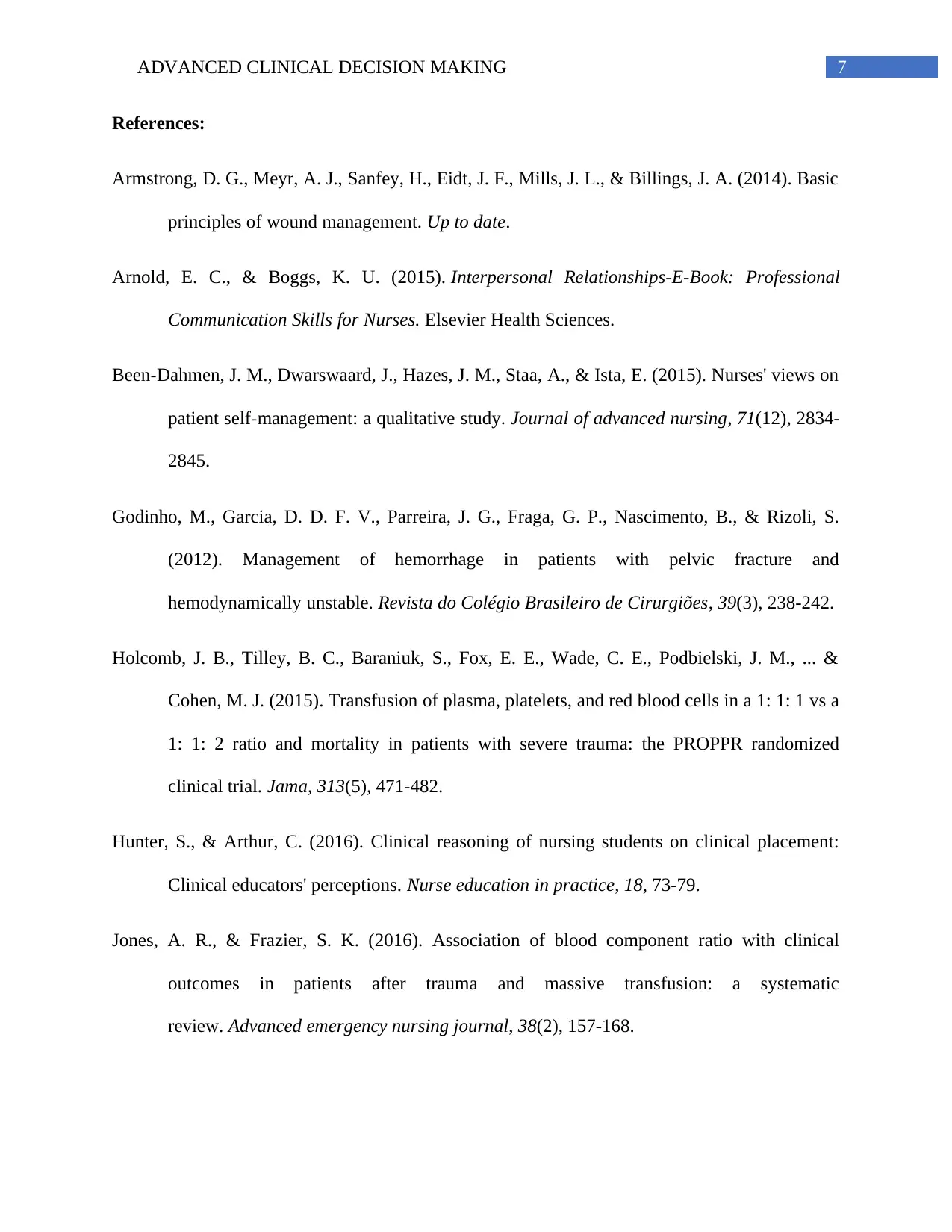
7ADVANCED CLINICAL DECISION MAKING
References:
Armstrong, D. G., Meyr, A. J., Sanfey, H., Eidt, J. F., Mills, J. L., & Billings, J. A. (2014). Basic
principles of wound management. Up to date.
Arnold, E. C., & Boggs, K. U. (2015). Interpersonal Relationships-E-Book: Professional
Communication Skills for Nurses. Elsevier Health Sciences.
Been‐Dahmen, J. M., Dwarswaard, J., Hazes, J. M., Staa, A., & Ista, E. (2015). Nurses' views on
patient self‐management: a qualitative study. Journal of advanced nursing, 71(12), 2834-
2845.
Godinho, M., Garcia, D. D. F. V., Parreira, J. G., Fraga, G. P., Nascimento, B., & Rizoli, S.
(2012). Management of hemorrhage in patients with pelvic fracture and
hemodynamically unstable. Revista do Colégio Brasileiro de Cirurgiões, 39(3), 238-242.
Holcomb, J. B., Tilley, B. C., Baraniuk, S., Fox, E. E., Wade, C. E., Podbielski, J. M., ... &
Cohen, M. J. (2015). Transfusion of plasma, platelets, and red blood cells in a 1: 1: 1 vs a
1: 1: 2 ratio and mortality in patients with severe trauma: the PROPPR randomized
clinical trial. Jama, 313(5), 471-482.
Hunter, S., & Arthur, C. (2016). Clinical reasoning of nursing students on clinical placement:
Clinical educators' perceptions. Nurse education in practice, 18, 73-79.
Jones, A. R., & Frazier, S. K. (2016). Association of blood component ratio with clinical
outcomes in patients after trauma and massive transfusion: a systematic
review. Advanced emergency nursing journal, 38(2), 157-168.
References:
Armstrong, D. G., Meyr, A. J., Sanfey, H., Eidt, J. F., Mills, J. L., & Billings, J. A. (2014). Basic
principles of wound management. Up to date.
Arnold, E. C., & Boggs, K. U. (2015). Interpersonal Relationships-E-Book: Professional
Communication Skills for Nurses. Elsevier Health Sciences.
Been‐Dahmen, J. M., Dwarswaard, J., Hazes, J. M., Staa, A., & Ista, E. (2015). Nurses' views on
patient self‐management: a qualitative study. Journal of advanced nursing, 71(12), 2834-
2845.
Godinho, M., Garcia, D. D. F. V., Parreira, J. G., Fraga, G. P., Nascimento, B., & Rizoli, S.
(2012). Management of hemorrhage in patients with pelvic fracture and
hemodynamically unstable. Revista do Colégio Brasileiro de Cirurgiões, 39(3), 238-242.
Holcomb, J. B., Tilley, B. C., Baraniuk, S., Fox, E. E., Wade, C. E., Podbielski, J. M., ... &
Cohen, M. J. (2015). Transfusion of plasma, platelets, and red blood cells in a 1: 1: 1 vs a
1: 1: 2 ratio and mortality in patients with severe trauma: the PROPPR randomized
clinical trial. Jama, 313(5), 471-482.
Hunter, S., & Arthur, C. (2016). Clinical reasoning of nursing students on clinical placement:
Clinical educators' perceptions. Nurse education in practice, 18, 73-79.
Jones, A. R., & Frazier, S. K. (2016). Association of blood component ratio with clinical
outcomes in patients after trauma and massive transfusion: a systematic
review. Advanced emergency nursing journal, 38(2), 157-168.
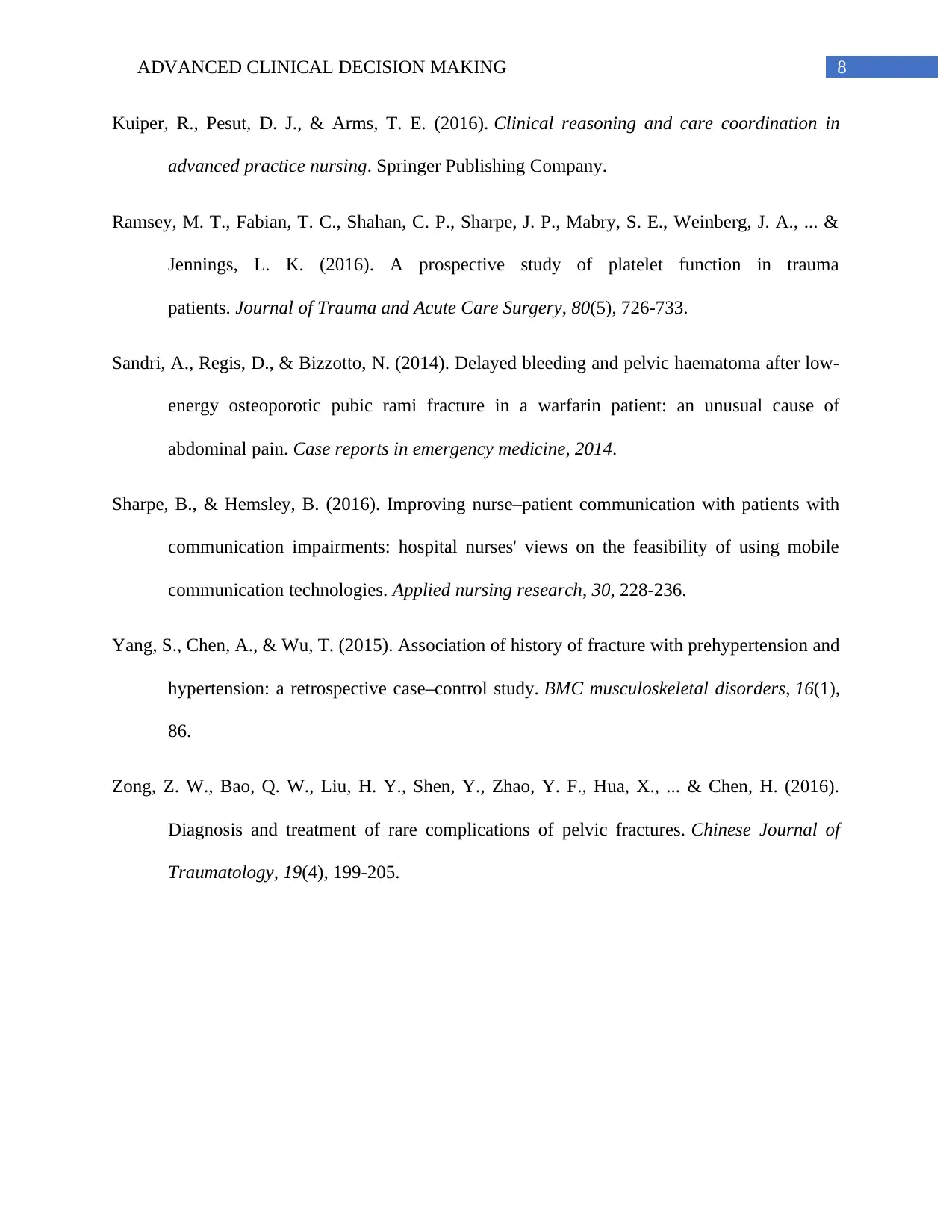
8ADVANCED CLINICAL DECISION MAKING
Kuiper, R., Pesut, D. J., & Arms, T. E. (2016). Clinical reasoning and care coordination in
advanced practice nursing. Springer Publishing Company.
Ramsey, M. T., Fabian, T. C., Shahan, C. P., Sharpe, J. P., Mabry, S. E., Weinberg, J. A., ... &
Jennings, L. K. (2016). A prospective study of platelet function in trauma
patients. Journal of Trauma and Acute Care Surgery, 80(5), 726-733.
Sandri, A., Regis, D., & Bizzotto, N. (2014). Delayed bleeding and pelvic haematoma after low-
energy osteoporotic pubic rami fracture in a warfarin patient: an unusual cause of
abdominal pain. Case reports in emergency medicine, 2014.
Sharpe, B., & Hemsley, B. (2016). Improving nurse–patient communication with patients with
communication impairments: hospital nurses' views on the feasibility of using mobile
communication technologies. Applied nursing research, 30, 228-236.
Yang, S., Chen, A., & Wu, T. (2015). Association of history of fracture with prehypertension and
hypertension: a retrospective case–control study. BMC musculoskeletal disorders, 16(1),
86.
Zong, Z. W., Bao, Q. W., Liu, H. Y., Shen, Y., Zhao, Y. F., Hua, X., ... & Chen, H. (2016).
Diagnosis and treatment of rare complications of pelvic fractures. Chinese Journal of
Traumatology, 19(4), 199-205.
Kuiper, R., Pesut, D. J., & Arms, T. E. (2016). Clinical reasoning and care coordination in
advanced practice nursing. Springer Publishing Company.
Ramsey, M. T., Fabian, T. C., Shahan, C. P., Sharpe, J. P., Mabry, S. E., Weinberg, J. A., ... &
Jennings, L. K. (2016). A prospective study of platelet function in trauma
patients. Journal of Trauma and Acute Care Surgery, 80(5), 726-733.
Sandri, A., Regis, D., & Bizzotto, N. (2014). Delayed bleeding and pelvic haematoma after low-
energy osteoporotic pubic rami fracture in a warfarin patient: an unusual cause of
abdominal pain. Case reports in emergency medicine, 2014.
Sharpe, B., & Hemsley, B. (2016). Improving nurse–patient communication with patients with
communication impairments: hospital nurses' views on the feasibility of using mobile
communication technologies. Applied nursing research, 30, 228-236.
Yang, S., Chen, A., & Wu, T. (2015). Association of history of fracture with prehypertension and
hypertension: a retrospective case–control study. BMC musculoskeletal disorders, 16(1),
86.
Zong, Z. W., Bao, Q. W., Liu, H. Y., Shen, Y., Zhao, Y. F., Hua, X., ... & Chen, H. (2016).
Diagnosis and treatment of rare complications of pelvic fractures. Chinese Journal of
Traumatology, 19(4), 199-205.
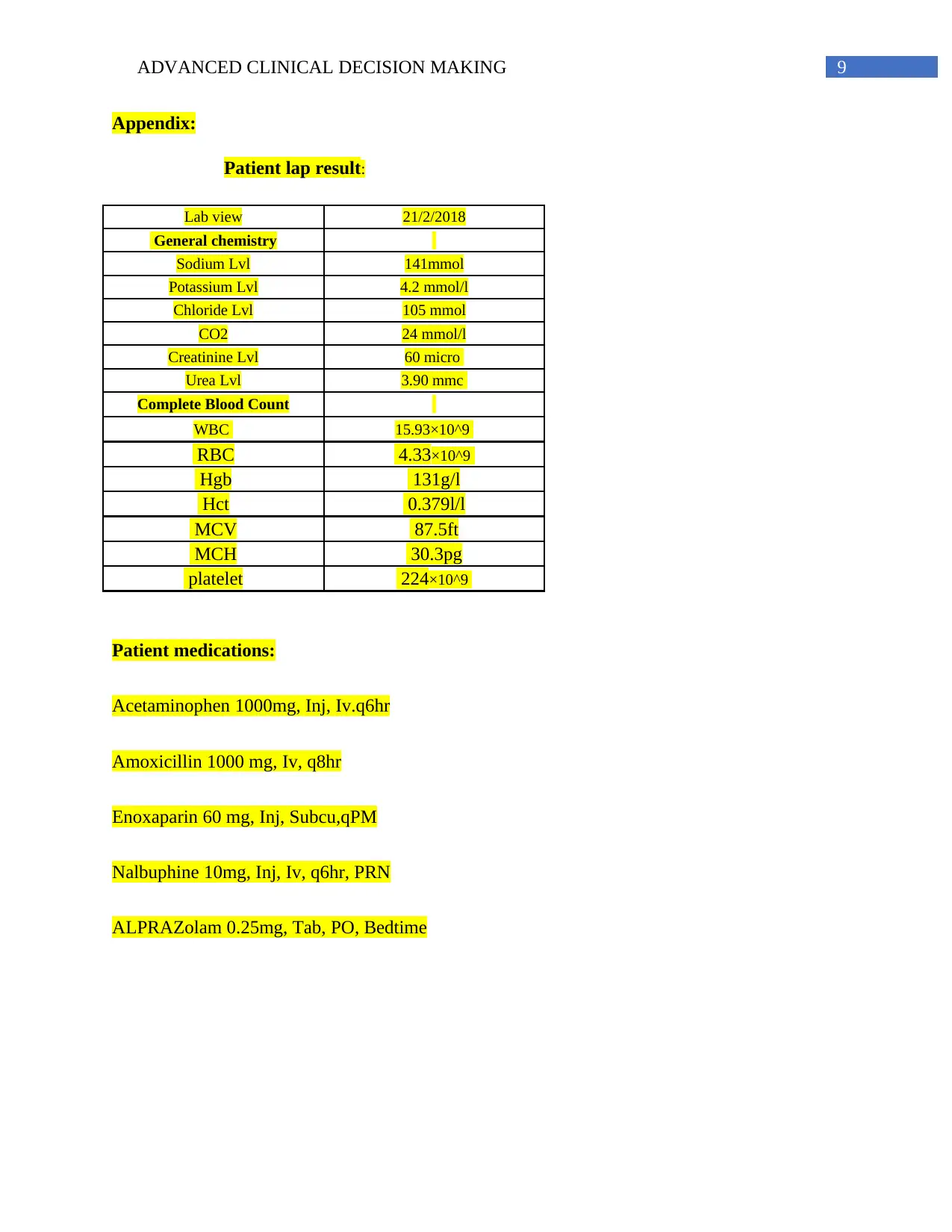
9ADVANCED CLINICAL DECISION MAKING
Appendix:
Patient lap result:
Lab view 21/2/2018
General chemistry
Sodium Lvl 141mmol
Potassium Lvl 4.2 mmol/l
Chloride Lvl 105 mmol
CO2 24 mmol/l
Creatinine Lvl 60 micro
Urea Lvl 3.90 mmc
Complete Blood Count
WBC 15.93×10^9
RBC 4.33×10^9
Hgb 131g/l
Hct 0.379l/l
MCV 87.5ft
MCH 30.3pg
platelet 224×10^9
Patient medications:
Acetaminophen 1000mg, Inj, Iv.q6hr
Amoxicillin 1000 mg, Iv, q8hr
Enoxaparin 60 mg, Inj, Subcu,qPM
Nalbuphine 10mg, Inj, Iv, q6hr, PRN
ALPRAZolam 0.25mg, Tab, PO, Bedtime
Appendix:
Patient lap result:
Lab view 21/2/2018
General chemistry
Sodium Lvl 141mmol
Potassium Lvl 4.2 mmol/l
Chloride Lvl 105 mmol
CO2 24 mmol/l
Creatinine Lvl 60 micro
Urea Lvl 3.90 mmc
Complete Blood Count
WBC 15.93×10^9
RBC 4.33×10^9
Hgb 131g/l
Hct 0.379l/l
MCV 87.5ft
MCH 30.3pg
platelet 224×10^9
Patient medications:
Acetaminophen 1000mg, Inj, Iv.q6hr
Amoxicillin 1000 mg, Iv, q8hr
Enoxaparin 60 mg, Inj, Subcu,qPM
Nalbuphine 10mg, Inj, Iv, q6hr, PRN
ALPRAZolam 0.25mg, Tab, PO, Bedtime
1 out of 10
Related Documents
Your All-in-One AI-Powered Toolkit for Academic Success.
+13062052269
info@desklib.com
Available 24*7 on WhatsApp / Email
![[object Object]](/_next/static/media/star-bottom.7253800d.svg)
Unlock your academic potential
© 2024 | Zucol Services PVT LTD | All rights reserved.





